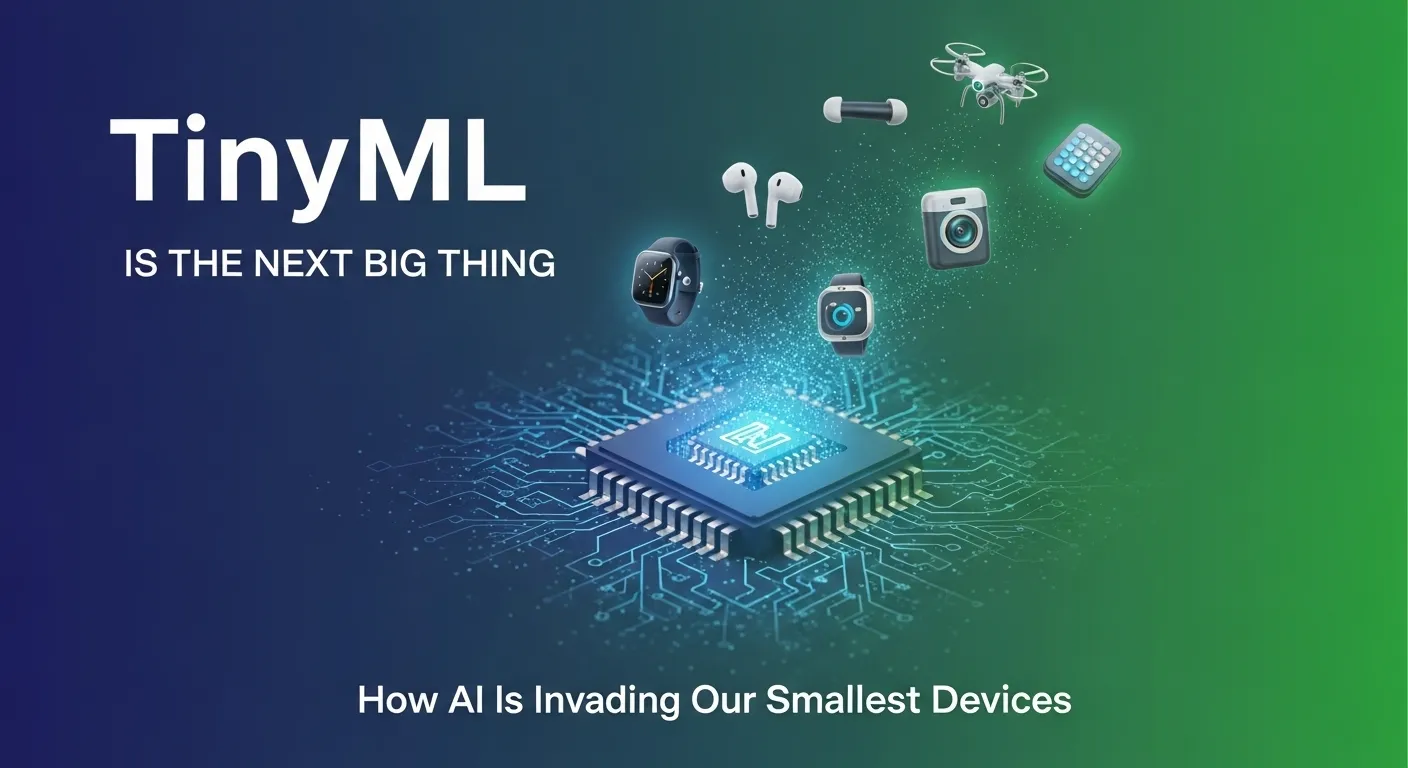Forget massive server farms—the future of artificial intelligence is fitting inside a device smaller than your thumbnail. Welcome to the world of TinyML, where AI models are shrinking down to run on microcontrollers that cost less than your morning coffee.
What Is TinyML?
TinyML (Tiny Machine Learning) is the art of shrinking AI models to run on microcontrollers—those tiny, low-power chips found in everything from your smart thermostat to children’s toys. Think of it as taking the brainpower of ChatGPT and fitting it into a device that runs on a watch battery for months. While traditional AI requires cloud computing and expensive hardware, TinyML brings intelligence directly to the edge, enabling devices to make decisions without internet connectivity.
How It Actually Works
The magic happens through a three-step process: first, developers train machine learning models on powerful computers using frameworks like TensorFlow. Then, they use optimization tools to compress these models dramatically—removing unnecessary parameters and reducing precision. Finally, the tinyfied model gets deployed to microcontrollers using specialized software like TensorFlow Lite Micro. These optimized models can perform tasks like voice recognition, gesture detection, or anomaly identification while consuming just milliwatts of power.
Benefits & Use Cases
- Ultra-low power consumption — Devices can run for months or years on small batteries, perfect for remote monitoring applications
- Real-time processing — No latency from cloud communication, crucial for safety-critical applications like industrial equipment monitoring
- Privacy preservation — Data stays on-device, eliminating privacy concerns associated with cloud-based AI
- Cost efficiency — Microcontrollers cost dollars instead of hundreds, making AI accessible for mass production
Real-world applications are already everywhere: smart agriculture sensors that detect soil moisture, industrial predictive maintenance systems, wearable health monitors that detect falls, and even “smart” trash cans that sort recycling automatically.
Costs/Pricing
The beauty of TinyML lies in its affordability. Development boards like Arduino Nano 33 BLE Sense or SparkFun Edge cost between $20-50, while production microcontrollers can be as cheap as $1-5 per unit. Cloud-based AI alternatives typically require ongoing subscription fees and computing costs that can run hundreds of dollars monthly for similar functionality. The open-source nature of most TinyML tools means you’re mainly investing in development time rather than expensive licenses.
U.S. Market Insights
American companies are leading the TinyML revolution, with Silicon Valley startups and established tech giants alike investing heavily. Companies like Google with their TensorFlow Lite Micro framework and Arduino with their specialized boards are making the technology accessible to U.S. developers and manufacturers. The trend aligns perfectly with growing concerns about data privacy and the push for more sustainable, energy-efficient technology solutions across American industries.
Alternatives & Comparisons
- Cloud AI (AWS, Google Cloud): Powerful but requires constant internet, higher latency, ongoing costs, and privacy concerns
- Edge Computing with GPUs: More processing power but significantly higher energy consumption and cost—unsuitable for battery-operated devices
- Traditional Embedded Systems: Reliable but lacks intelligence—can’t adapt or learn from new data patterns
Getting Started Guide
- Choose your hardware — Start with an Arduino Nano 33 BLE Sense or similar development board (around $30)
- Set up your environment — Install TensorFlow Lite Micro and the Arduino IDE with relevant libraries
- Train and compress your model — Use TensorFlow to create your AI model, then optimize it for microcontrollers
- Deploy and test — Load your model onto the microcontroller and start collecting real-world data
- Iterate and improve — Use the data from your deployed devices to retrain and enhance your models
FAQs
How powerful are TinyML devices really?
While they can’t run ChatGPT, TinyML devices excel at specific, focused tasks. They can recognize voice commands, detect anomalies in sensor data, classify images, and make predictions based on patterns—all while using minimal power.
What programming languages do I need?
Python for training models and C++ for deployment are the most common. Many developers start with existing examples and modify them for their specific needs.
Is TinyML just a passing trend?
Industry analysts project the TinyML market to grow from $400 million in 2023 to over $2 billion by 2028, indicating this is a fundamental shift in how we deploy AI, not just a temporary buzzword.
Bottom Line
TinyML represents the democratization of artificial intelligence—bringing smart capabilities to everyday objects without the cloud dependency, high costs, or privacy concerns. Whether you’re a developer looking to build the next generation of smart devices or a business seeking efficient AI solutions, the tiny revolution is worth paying attention to. Got questions about implementing TinyML in your projects? Share them in the comments below!

